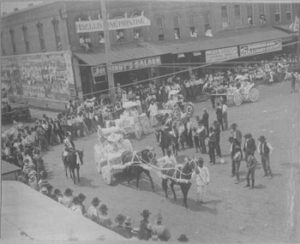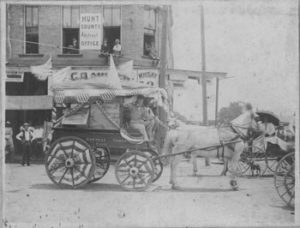Seasonal sales are not unusual. But at the turn of the 20th century, merchants throughout

Turning the corner at Washington and Johnson Streets, the beautiful Mississippi Store float with yellow and white paper flowers intrigued on-lookers.
Northeast Texas held street carnivals with elaborate parades, sham battles, balloon ascensions, and music to attract crowds from as far away as Jefferson, Paris, Canton and Sherman.
Railroads cooperated by offering special fares, including two back-to-back round trip tickets. Visitors could arrive in time to see the opening parade and some of the attractions, catch the train home in time to feed the livestock and sleep in their own beds, before doing a repeat performance of new events the next day.
The events were held in mid-week. Many Americans did not have weekends, work of some sort was done daily. But mid-summer was the best time to leave crops and livestock less attended.
The organizers were merchants and one reason for the celebration was sales. However, neighboring towns competed for the best entertainment to go with shopping. Since all local fire departments were volunteers, towns brought their firemen and equipment on trains to compete in races. Every town or at least county had a local militia, then known as a branch of the Texas Guard. Groups participated in sham battles. Men enjoyed these affairs and were content to let their wives and daughters shop.
The most spectacular part of Summer Street Carnivals was none of those activities. It was the Grand Parade. All the visitors hurriedly scouted a good spot to watch the event. Almost every second floor window looking over the parade route was filled with young men and boys. Special scaffolds were built for ladies to enjoy the view. Horses, buggies, and wagons were pulled up to the parade route with chairs and standing space for those riding in them.

The American Express workers decorated on of their freight wagons in very patriotic colors. Note the young men sitting in the windows.
Once the parade began with its colorful floats and carriages decorated with paper flowers, excitement filled the air. The parade route began at Washington and Stonewall Streets, circled the courthouse and headed out Lee Street. At Sayle Street the route turned south to Washington where they slowly moved eastward to Wesley Street. There the route turned south until reaching Oneal Street where it turned east. The route followed Oneal to Bois d’Arc before turning west on Jones. From there the floats, carriages, and marchers headed north up Stonewall to the courthouse. No one went home then, though. Carriages and floats were parked around the courthouse square among booths offering delicacies and drinks, especially water.
All of these activities were held on dirt streets. There was no paving in Greenville at that time. Women came decked out in what appears to be ankle-length white dresses, dark stockings, elaborate hats, and frilly parasols. Many men wore coats and ties.
The late Jack Horton gave me an album he was given as a child. In it are more than 100 photographs of one parade. I have looked at all of them very closely and have not seen one bare foot. However, as the parade made its way out of downtown Greenville, the styles of clothing were less fancy. Men even appeared with out coats. I presented a program with these photographs to a group of older women recently. One woman noted that most people at the parade were not poor.
